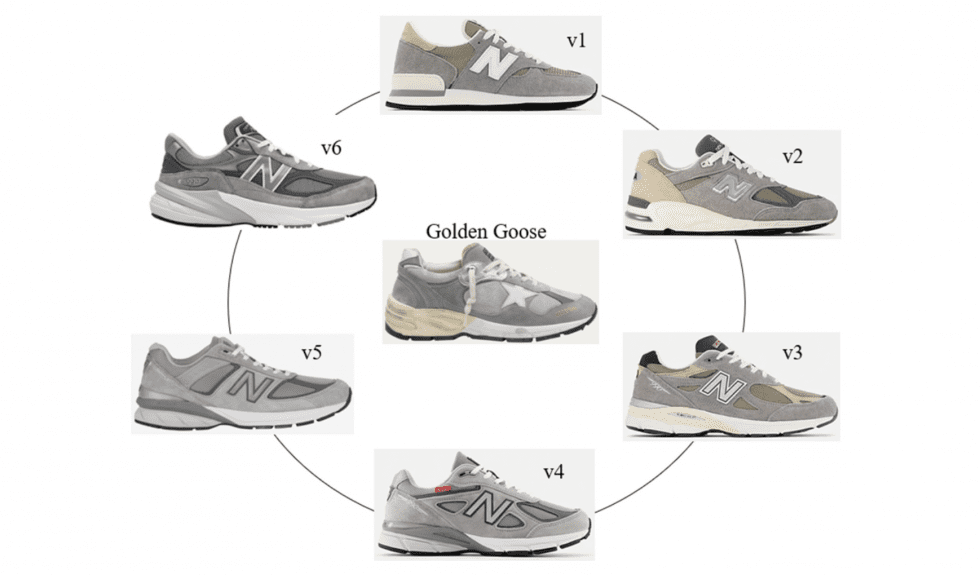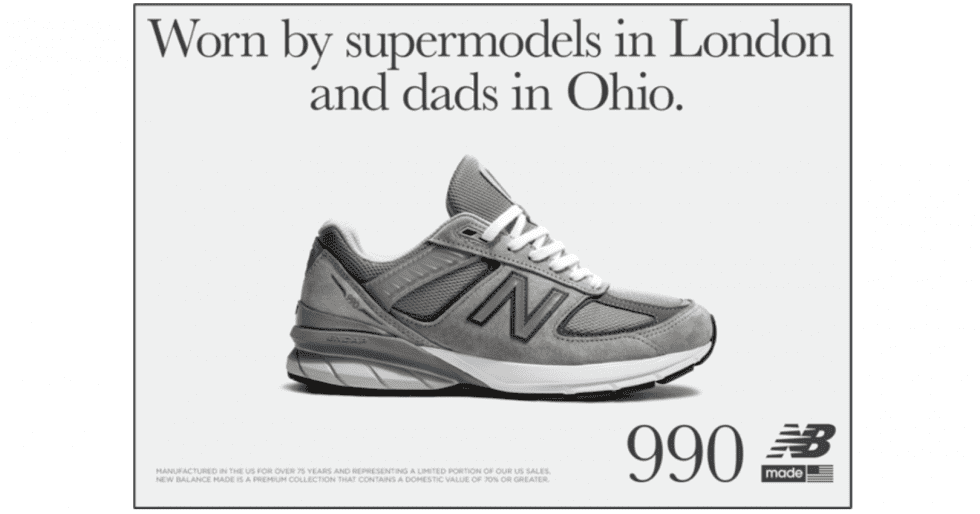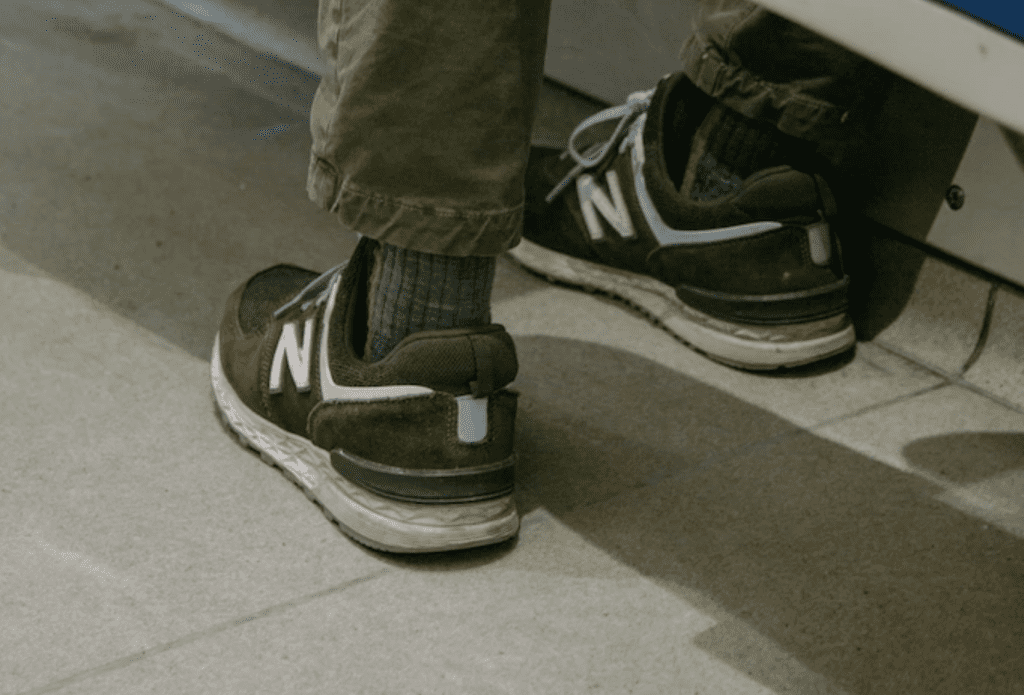New Balance is taking on a fellow footwear maker for allegedly hijacking the design of its dad shoes. According to the complaint that it filed with a federal court in Massachusetts on August 18, New Balance claims that “serial copyist” Golden Goose is on the hook for willfully infringing and diluting the common law trade dress that it has amassed in its 990 sneakers to “foster a perceived association between its products and New Balance in the minds of consumers” when no such association exists. Boston-based New Balance contends that Golden Goose has gone further to create consumer confusion by “mimicking [its] core colorways” and adopting a copycat style name – “Dad-Star” – which New Balance says is a direct play on its “well-known” status as the “dad shoe” brand.
Setting the stage in the newly-filed complaint, New Balance asserts that it first introduced its 990 sneaker in 1982, and the sneaker has evolved across six versions, each of which continue to be sold today. “Although the versions have some design differences, all of them … use a common design language to incorporate a particular 990 ‘look’ that consumers exclusively associate with New Balance as source,” the footwear company claims, noting that it is “careful not to change the design too much from one version to the next” in order to preserve the “distinctive ‘look.’”
In furtherance of its sale of its staple 990 sneakers, New Balance claims that it has generated “many hundreds of millions of dollars in revenue,” has sold more than a million pairs of each 990 v1 through 990 v5, and has spent “many millions of dollars” to promote the sneaker collection. For example, since the launch of the 990 v6 sneaker in November 2022, New Balance says that it has spent approximately $1.5 million to promote the sneaker and has “already sold hundreds of thousands of pairs.”

Against that background and given that the 990 is frequently the subject of unsolicited media coverage, New Balance alleges that it has developed protectable rights in at least the following combination of elements: “(i) Upper composed primarily of multiple tones of a single color (usually grey, blue, or black); (ii) Upper including mesh underlay with suede overlay creating mesh windows in forefoot and midfoot; (iii) Overlay bars in lateral and medial forefoot regions; (iv) Midsole having forefoot-to-midfoot portion of a first color (usually white) and different colored (usually grey) midfoot-to-heel portion; (v) Outsole of contrasting color (usually predominantly black); (vi) Reflective accents in upper; and (vii) Reinforced rear eyelets (usually two on both medial and lateral sides).”
Dad Sneaker vs. Dad-Star
Fast forward almost 40 years from when it first began selling its 990 sneaker, and New Balance maintains that Golden Goose started selling a shoe called the “Dad-Star” using a design that mirrors the 990 trade dress. By adopting the “Dad-Star” model, New Balance asserts that Golden Goose is using a name that “uniquely indicates New Balance” since it is “well-known as the ‘dad shoe’ brand and fosters an association with the term.” Within the New Balance sneaker family, “the 990 is known to consumers as the ‘original’ dad shoe,” per New Balance, which says that it “famously embraced” the seemingly incongruent demographic appeal of the 990 as part of a global marketing campaign.”

“In addition to adopting a confusingly similar design” and style name, New Balance alleges that Golden Goose “prominently use[s] shades of grey in its infringing shoe model, which increases the likelihood of confusion, [as] New Balance and the 990 model are famously associated with the color grey.”
Specifically, New Balance claims that it has: (1) Made a point to ensure that all of its core models are available in grey colorways, which it “makes available in the first or second season of availability,” (2) Spent “many millions of dollars and thousands of hours creating and fostering [its] distinctive association with the color grey” by featuring “grey colorways and grey themes” in many of its ads, (3) Sold a sizable number of grey sneakers, with “approximately one third” of all of the shoes it sells being in grey colorways, which “represents many millions of pairs of shoes and hundreds of millions of dollars in revenue,” and (4) Engaged in marketing activities, such as “Grey Day,” which it has celebrated since 2018 to “focus on the company’s heritage and long-standing relationship with the color grey.”
TLDR: “Given the renown of the New Balance 990 and Golden Goose’s use of a virtually identical trade dress, the color grey, and the model name ‘Dad-Star,’ ordinary consumers are likely to be confused and erroneously believe that New Balance has an affiliation, connection, or association with the Golden Goose shoe, or that New Balance has sponsored or approved the use of the design by Golden Goose,” New Balance alleges.
In response to what it calls “another example of Golden Goose free riding on the creative work and goodwill of others,” New Balance sets out claims of false designation of origin, trademark infringement, and trademark dilution, and is seeking injunctive relief (including an order recalling all of Golden Goose’s footwear products bearing the 990 trade dress) and monetary damages.
The Bigger Picture
Legal clashes between obvious rivals, such as Nike and adidas, have been common in the sportswear space to date, driven by the intensity of competition among rivals, the lifespan of – and the potentially-lengthy window to drive revenue from – staple sneaker styles, and the level of R&D at play, which give rise to incentives for companies to defend their valuable brands and their innovations.
While cases continue to pit the likes of Nike, adidas, Puma, Brooks, Skechers, and co. against one another over sneaker designs and trademarks, alike, in recent years, cases pitting companies in formerly-distinct segments of the larger footwear/sportswear market have started to become increasingly common. The trademark lawsuit that adidas waged against high fashion brand Thom Browne comes to mind here. Thom Browne prevailed at the district court level due, in large part, to its ability to convince jurors that the likelihood of consumers confusing the source of goods bearing its 4-stripe pattern with those emblazoned with adidas’ 3-stripe mark was low thanks to the companies’ respective positioning in the market and their often-drastically-different price points.
Such different positioning (high fashion vs. mass-market sportswear) did not stop adidas from filing suit against Thom Browne, of course. Adidas was largely motivated to lodge trademark claims against Thom Browne as a result of the latter’s efforts to “encroach” on its turf, the sportswear market. But more broadly, the case – and the one at hand – reflects the the fact that a growing number of companies are inching into new markets in order to cater to existing consumers and/or to reach new ones, thereby, blurring the lines between fashion and athleticwear. Rising prices for sportswear offerings and an ever-growing number of collaborations between sportswear and fashion brands serves to blur this already-hazy-line even further, and potentially create confusion among consumers.
This is where New Balance and Golden Goose come in, particularly as when it comes to rising price tags, collaborations, and the blurring of sports shoes and fashion footwear, New Balance is no stranger to these phenomena. The company’s footwear – which is stocked on fashion-centric platforms like Net-a-Porter, Farfetch, SSENSE, etc. – regularly reaches the $400 mark and into the $900 range in some cases, thanks to collaborations with fashion brands, such as Miu Miu, Aimé Leon Dore, and Junya Watanabe, among others. This puts in the same relative realm as Golden Goose, which sells sneakers that are handmade in Italy and are priced at upwards of $500 per pair.
All in all, companies’ efforts to expand beyond their most traditional offerings to a broader array of goods/services or in New Balance’s cases, the same general offerings but at markedly higher price points, brings with it opportunities to boost revenues. At the same time, these endeavors could bring about additional issues from an infringement perspective (namely, due to a heightened relatedness of goods/services), including a broader pool of parties to face off against.
A representative for Golden Goose was not immediately available for comment.
The case is New Balance Athletics, Inc. v. Golden Goose USA, Inc., 1:23-cv-11898 (D.Mass.).
Updated
April 5, 2024
New Balance and Golden Goose have settled the case, alerting the court that they have stipulated and agreed that “all of New Balance’s claims in this action are dismissed with prejudice,” and Golden Goose’s counterclaims are dismissed without prejudice, with each party bearing its own costs and attorneys’ fees.











